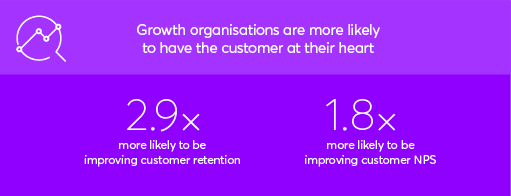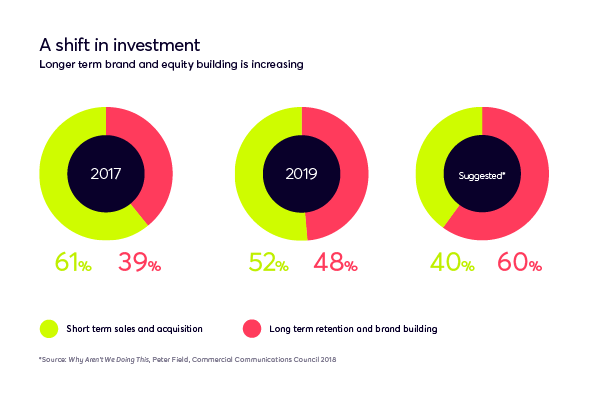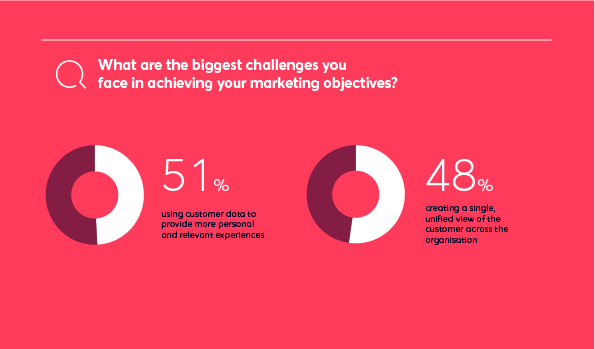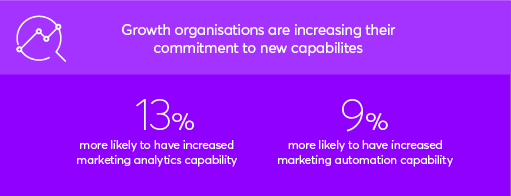
First Published: 15 September, 2019
This revelation was a concern to hear from some of New Zealand’s most senior markets. It was concerning because these were talented marketers and marketing’s core purpose is growth, so understanding what is or isn’t going on here should be of great interest to us all. Marketers delivering on the promise of growth is important to the profession, NZ businesses and the economy.
The MA partnered with Qrious on this research project to understand what successful businesses are doing from a marketing perspective and to provide insight to allow other marketers to re-calibrate their efforts and gain the support needed from their c-suite for investment. We wanted to know from senior marketers what was on their minds, how their businesses were performing and what initiatives they are planning.
The output was intriguing with only 27% of the respondents’ businesses growing and the reality that they are doing something different than the rest in 4 areas that underpin growth.

The first growth area identified was putting the customer at the heart of a business, but this is no new mantra to any of us. The problem though is whilst companies talk in this way, they don’t always manage to live it.
“A change of ownership has brought a stronger focus on customer experience. We now view our business through the customer lens.” - Marketing Director Retail
What surprised me from the research was that only 25% of our leading marketers believe their businesses are walking the talk when it comes to being customer-centric. I admire the honesty of respondents in calling out their organisations need to do more, with 50% saying their organisation knows that there is a gap and they are doing something about it, but the remaining 25% of marketers are very concerned that their organisation may not bridge the gap to become customer-led. I don’t need to say it, you don’t want to be in this 25%!
Digging deeper into the issue, it is clear the bar has been raised for what marketers and customers now define as being a customer-led organisation. In the past, researching customers to generate insights and strategy, followed by creating persona groups and developing integrated marketing campaigns was a great start to being customer-centric. Not anymore though as data, technology and Customer Experience has raised the standards for what can be tracked, analysed and responded to. The bar has been raised way high!
There was a trend coming through from the research for what is holding back many organisations in being customer-led and this trend provides guidance on where marketers need to push harder:
If proof is what you need to support the customer customer-led movement in your organisation then the insights we obtained from the performance metrics speak for themselves. From the 110 companies interviewed, customer-led organisations outperformed the rest on all KPIs measured:
Our marketers also identified that the two biggest trends likely to impact the marketing environment in the next 3 years are heavily related to customer-centricity. The first is the personalisation of customer journeys and involves understanding the full 360-degree journey, having timely info during the journey and the ability to react/interact to improve the experience. The second significant trend was that of privacy, use and misuse of consumer data.

The second area contributing to the growth phenomenon was organisations taking a longer view. Finally, are we are witnessing in New Zealand support from the c-suite for increasing investment in longer-term marketing initiatives. We discovered that businesses are improving the investment balance in favour of longer-term goals and aspirations rather than a short-term increase in likes or sales.
“We have been focussed on short term tactics and are in the process of re-orienting the expectations of marketing towards long term goals and aspirations” - Head of Content Public Sector
Hallelujah, I hear you say! Yes, marketers are getting support to invest more in the brand and areas like emotion storytelling. The numbers from respondents tell us that marketers are now spending 48% of their budget on longer view initiatives, up from 39% in 2017, but this is still below the widely quoted international benchmark of 60%. I say let’s take this 50%, prove to the business what can be done with it and then confidently ask for 55%-60% next year.
The caution though for marketers with this increased responsibility for allocating more to long-term initiatives is that you need to be disciplined. A marketer’s intuition, instinct and the need to act quickly can distract and lead many down the path of short-term rather than holding firm and investing the time and money in future returns. The message here is to ensure you have a disciplined approach to developing your long-term initiatives and not to give in to the temptation to react.

Making changes to how your organisation evolves with data cannot be delayed any longer, but many marketers need help on this front as 80% of respondents identified they don’t understand how to get value from the data in their organisation.
Growth companies are creating rich, data-driven personalised experiences and have clearly defined KPIs proving ROI.
“We need data to inform what we’re doing and to inform others across the business of our work. Data is also helping us become far more focused on customer outcomes and ROI.” - CMO Financial Services
In the past data has been heavily used for short term acquisition campaigns, but this has changed. The trend is moving towards longer-term nurturing of customers by utilising data for improving the customer experience for supporting retention. The fastest-growing areas seen in the evolution of data and analytics usage in marketing are for modelling loyalty, NPS and sentiment analysis.
This trend is backed up by growth companies telling us they are increasing the percentage of their marketing budget spent on data and analytics. These companies also don’t have data silos or a lack of capability like the ‘rest of’ group which has enabled the creation of a better view of their customers – a single customer view. Unfortunately, this remains a crucial gap for many businesses to resolve. The message here is ‘there is no alternative’, businesses need to invest in martech now to ensure they are not getting left behind in data, technology and people capabilities. The barriers need to be knocked down.
The 4 biggest barriers getting in the way of business using data and marketing analytics are:

We all know the world of marketing has changed significantly over the last 5 years, as has the environment for customers. This rapid change has put pressure on the skills required for individual marketers and teams to deliver to customer expectations.
It’s not surprising that many organisations have not kept up with the pace of change. That said, successful (growth) organisations have and they have done this through expanding their capability in the areas of customer, data and brand. It is pleasing to see that it’s not all about data and tech and that companies achieving growth have seen the need to raise the capability of their brand expertise. Getting the combination of data, tech, customer and brand right has been a differentiator for growth.
“Increasingly, the capability delivered by marketing is critical and is closely linked to our bottom line. Data, martech, CX and storytelling are all necessary to ensure we can become and remain personalised and relevant” - GM Customer and Marketing Consumer Services
The top 5 skills that businesses are looking to develop or grow in their marketing team are:
Summary
So, if only 27% of businesses are growing and we can attribute 4 key areas to driving this growth, what should marketers in the other 73% do? The insights from the growth organisations are clear and provide a great starting place:
Remember, the bar has been raised on all 4 areas and marketers need to be disciplined in their approach if they are to join the 27% club, the club that is doing something different and growing!

Contact us if you have any suggestions on resources you would like to see more of, or if you have something you think would benefit our members.
Get in TouchSign up to receive updates on events, training and more from the MA.
